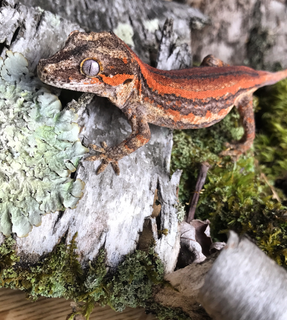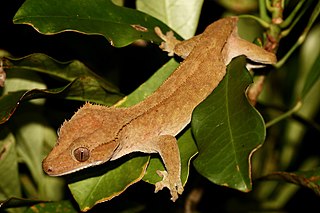
Bavayia is a genus of lizards in the family Diplodactylidae. Species in the genus Bavayia are also known commonly as New Caledonian geckos or bavayias. The genus is native to the remote New Caledonia and Loyalty Islands. The 12 species are moderately small to medium-sized geckos, and are distinguished from other genera by their tail length and the shape of their digits.

Eurydactylodes is a small genus of geckos commonly referred to as chameleon geckos from the subfamily Diplodactylidae, endemic to New Caledonia and few adjacent islands. Within the Diplodactylidae, Eurydactylodes resides in the Carphodactylini tribe, and consists of four species. All species share similar morphology as well as lifestyle and habits. The first of the Eurydactylodes species to be classified, E. vieillardi, was discovered in 1869.

Rhacodactylus is a genus of medium to large geckos of the family Diplodactylidae. All species in this genus are found on the islands that make up New Caledonia.

The gargoyle gecko, knob-headed giant gecko, New Caledonia bumpy gecko, or New Caledonian bumpy gecko is a species of gecko found only on the southern end of the island of New Caledonia. Its habitat is threatened by deforestation on the island. This species of gecko is the smallest of the six recognized species in its genus where they often reach about 125 mm in size. This gecko, along with several other Rhacodactylus species are being considered for protective measures by CITES, which would put restrictions on their exportation. This gecko was first described by Bavay in 1869.

The crested gecko or eyelash gecko is a species of gecko native to southern New Caledonia. In 1866, the crested gecko was described by a French zoologist named Alphonse Guichenot. This species was thought extinct until it was rediscovered in 1994 during an expedition led by Robert Seipp. Along with several other New Caledonian gecko species, it is being considered for protected status by the Convention on the International Trade in Endangered Species of Wild Flora and Fauna.

Rhacodactylus leachianus, commonly known as the New Caledonian giant gecko or Leach's giant gecko or colloquially Leachie, is a large species of gecko in the family Diplodactylidae. The species, which was first described by Georges Cuvier in 1829, is endemic to New Caledonia.

Mniarogekko chahoua is commonly known as the mossy New Caledonian gecko, short-snouted New Caledonian gecko, Bavay's giant gecko, or mossy prehensile-tailed gecko. It is an arboreal gecko found natively on the southern portion of the island of New Caledonia and on the outlying islands of Île des Pins.

Correlophus sarasinorum, also called commonly Roux's giant gecko, Sarasins' giant gecko, Sarasin's [sic] giant gecko (incorrectly), and the suras gecko, is a species of lizard in the family Diplodactylidae. The species is native to the southern portions of the outlying New Caledonian island of Grande Terre.
The rough-snouted giant gecko, also known as the greater rough-snouted gecko or tough-snouted gecko, is a species of gecko found in New Caledonia.

The harlequin gecko is a species of gecko, a lizard in the family Diplodactylidae. The species is endemic to Stewart Island/Rakiura in the far south of New Zealand, where it was discovered in 1969. In terms of distribution it is one of the southernmost gecko species in the world.

The Stephen's Island gecko, also known commonly as the Cook Strait striped gecko, Stephen's sticky-toed gecko, and the striped gecko, is a species of gecko in the genus Toropuku in the family Diplodactylidae. The species is endemic to New Zealand.

The Diplodactylidae are a family in the suborder Gekkota (geckos), with over 150 species in 25 genera. These geckos occur in Australia, New Zealand, and New Caledonia. Diplodactylids are the most ecologically diverse and widespread family of geckos in both Australia and New Caledonia, and are the only family of geckos found in New Zealand. Three diplodactylid genera have recently been split into multiple new genera.

Anthony Hume Whitaker was a New Zealand herpetologist, contributing a 50-year career of fieldwork, pioneering research and species discoveries. His is still the largest collection of reptile and amphibian specimens donated to Museum of New Zealand Te Papa Tongarewa.
New Caledonian gecko may refer to any of the below, both genera placed in the Diplodactylidae family, and found in New Caledonia:
Dierogekko validiclavis, also known as the bold-striped gecko, is a gecko endemic to Grande Terre in New Caledonia.
Dierogekko koniambo, also known as the Koniambo striped gecko, is a gecko endemic to Grande Terre in New Caledonia.
Dierogekko thomaswhitei, also known commonly as White's nimble gecko and the Taom striped gecko, is a species of lizard in the family Diplodactylidae. The species is endemic to New Caledonia.
Eurydactylodes occidentalis is a species of gecko, a lizard in the family Diplodactylidae. The species is endemic to Grande Terre in New Caledonia.
Paniegekko is a monotypic genus of geckos in the family Diplodactylidae, containing the species Paniegekko madjo. It is endemic to humid montane forests on Mont Ignambi and Mont Panié in the Panié massif of New Caledonia. It was once considered a species of Bavayia, a similar genus of arboreal geckos. Paniegekko madjo is endangered, owing to predation by introduced rodents and cats combined with habitat degradation by wildfires and introduced pigs and deer. It has not been observed since 1998.

Pygopodoidea is a gecko superfamily and the only taxon in the gekkotan subclade Pygopodomorpha. The clade includes three Australasian families: Diplodactylidae, Carphodactylidae, and Pygopodidae. Traditional gekkotan systematics had considered Diplodactylidae and Carphodactylidae as subfamilies of the family Gekkonidae, but recent molecular work have placed Pygopodidae within Gekkonidae making it paraphyletic. These analyses have shown support of Pygopodidae and Carphodactylidae being sister taxa, with Diplodactylidae occupying a basal position in Pygopodoidea.












